First Quarter 2025 Investment Commentary
Market Recap
Global stock markets were widely mixed across regions and styles over the first quarter. After hitting a new all-time high in mid-February, U.S. stocks (S&P 500 Index) suffered their first 10% correction since 2023 before recovering to end the quarter down 5% with fears about Chinese AI firm DeepSeek, combined with increasing trade tensions, being the catalyst. Smaller-cap U.S. stocks (Russell 2000 Index), which tend to be more volatile than their larger-cap counterparts, declined further, ending the quarter down 10%. Large-cap growth stocks (Russell 1000 Growth Index), which have led the market higher for several years, finally lagged this quarter as investors rotated into U.S. large-cap value (Russell 1000 Value) and foreign stocks (MSCI EAFE) amid economic uncertainty. The equal-weighted S&P 500 was slightly positive in the quarter, outperforming the cap-weighted index, signaling the decline of the “Magnificent 7,” which comprised one-third of the S&P 500 index at the start of the year. The Bloomberg Magnificent 7 Index was down 16% in the quarter. More speculative assets such as Bitcoin also fell, while investors’ anxiety was good for gold which reached a new high.
In contrast to the U.S., many European and Asian markets rose sharply. Developed International stocks (MSCI EAFE Index) gained nearly 7%, driven in large part by a fiscal policy shift in Germany focused on increased defense spending. Emerging market stocks (MSCI EM Index) also fared well, finishing the quarter up 3%. Gains in emerging markets were bolstered by China which delivered solid, double-digit returns of 15% (MSCI China Index).
Within fixed-income, both credit and interest-rate sensitive sectors posted gains in the quarter. The 10-year Treasury yield experienced significant volatility throughout the quarter, fluctuating amid shifting inflation expectations, Federal Reserve policy signals, and broader market uncertainty. Overall, 10-year Treasury rates ended up slightly lower, falling from 4.57% to 4.36%, and investment-grade core bonds (Bloomberg U.S. Aggregate Bond Index) rose just over 2% in the quarter. Credit-sensitive bonds such as high-yield held up well, gaining 1.5%. The overall outlook for bonds in 2025 is positive, with higher current yields likely resulting in calendar-year returns that exceed inflation.
Performance in the first quarter was a great reminder of the benefits of diversification. The downturn in U.S. growth stocks, in particular, was offset by gains in U.S. large cap value stocks, foreign stocks, and investment grade bonds. But in many ways the bigger story is being written in the days following the end of March, with tariff announcements being the dominant driver.
Macroeconomic and Investment Outlook
On April 2, President Trump surprised global investors by announcing a comprehensive set of much higher-than-expected tariffs (what he declared “Liberation Day”). These included a 10% baseline tariff on all imports and unexpected and significantly higher tariffs for certain trade partners, such as 54% for China and 20% for the European Union (as of the writing of this commentary). These tariffs in aggregate, if implemented and maintained, would result in the effective tariff rate on all imports rising to 24%, putting it at a 125-year high.
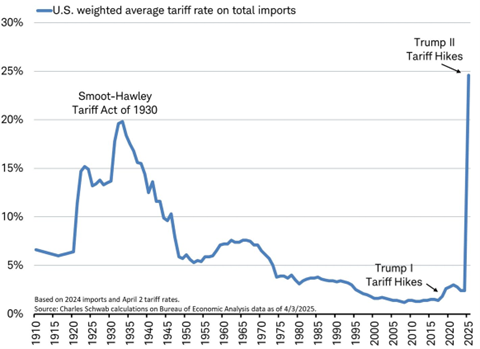
One week later, on April 9 President Trump announced a pause on some of the harshest tariffs, in response to which the market rallied, leading the S&P 500 index to its biggest one-day gain since 2008. This ever-changing tariff landscape has weighed heavily on investor sentiment, adding to overall uncertainty. Prior to the pause announcement, the S&P 500 had dropped by over 18% from its February 19th high, European and Asian stock indexes also fell meaningfully. The U.S. dollar weakened against major currencies, and longer-term interest rates fell over fears of an economic slowdown. Following the tariff pause the S&P 500 has recovered somewhat, and by April 11 was down just over 12% from its February 19th high.
Leading up to “Liberation Day,” economic conditions in the U.S. were reasonable and the overall economic backdrop was relatively stable. Despite ongoing volatility and concerns about slowing growth, there were signs of supportive underlying economic fundamentals. For example, corporate earnings continued to surprise to the upside, with many companies exceeding expectations and maintaining strong profit margins. GDP was still expanding, albeit at a slower pace, reflecting a resilient economy even in the face of higher interest rates. Meanwhile, the labor market remained in decent shape, with unemployment at historically low levels and key sectors such as construction, health care, technology, and professional services still adding jobs. Furthermore, consumer spending remained relatively steady, and businesses were yet to signal widespread distress.
But uncertainty over the ever-changing tariff landscape weighed heavily on investor sentiment, as concerns about a continued protectionist agenda could raise the risk of significantly slowing economic growth. In short, globalization has made it relatively easy to outsource manufacturing to countries with lower-cost and therefore more competitive work forces. This has resulted in the industrial sector of the U.S. economy stagnating in recent decades.
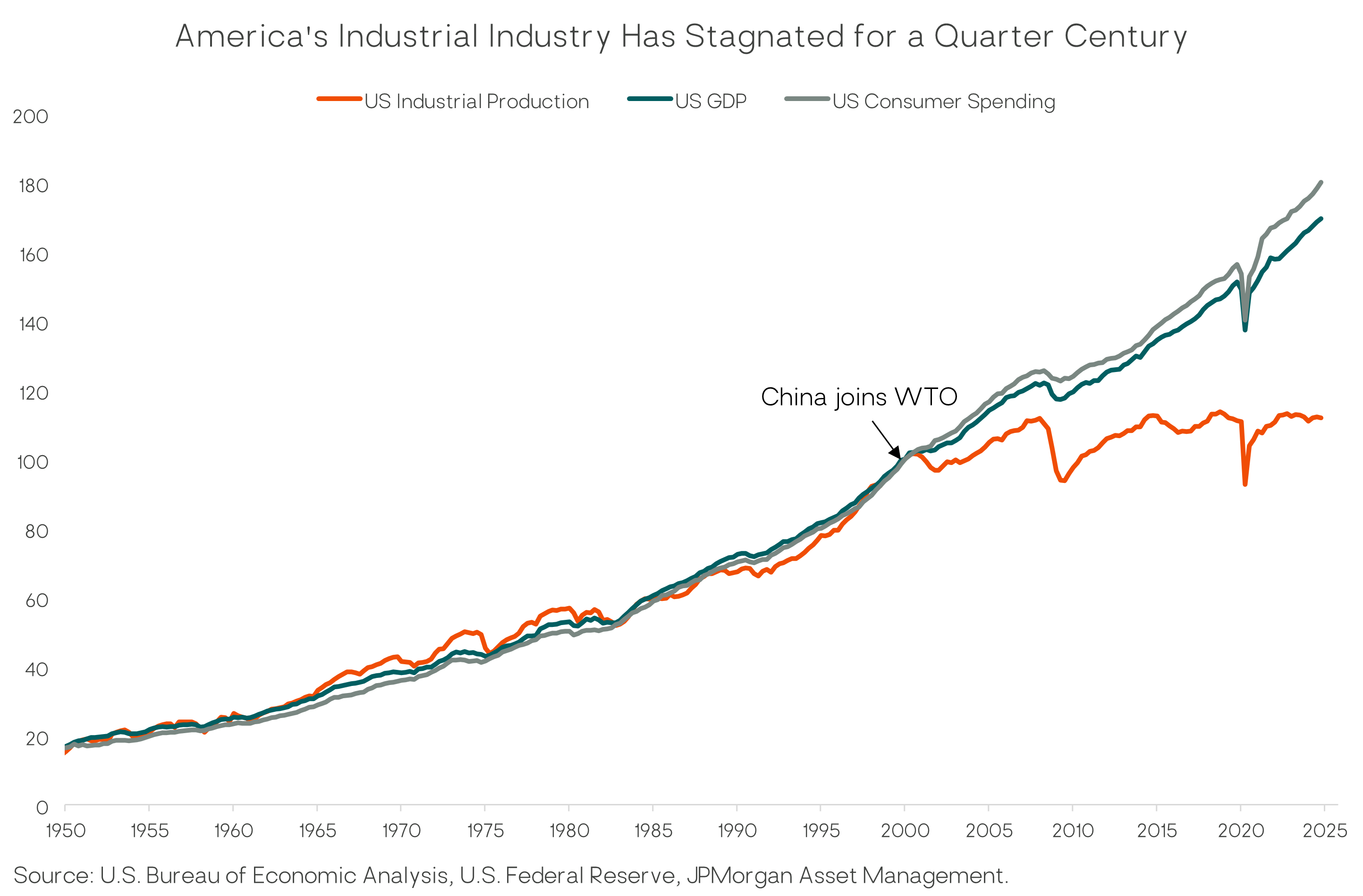
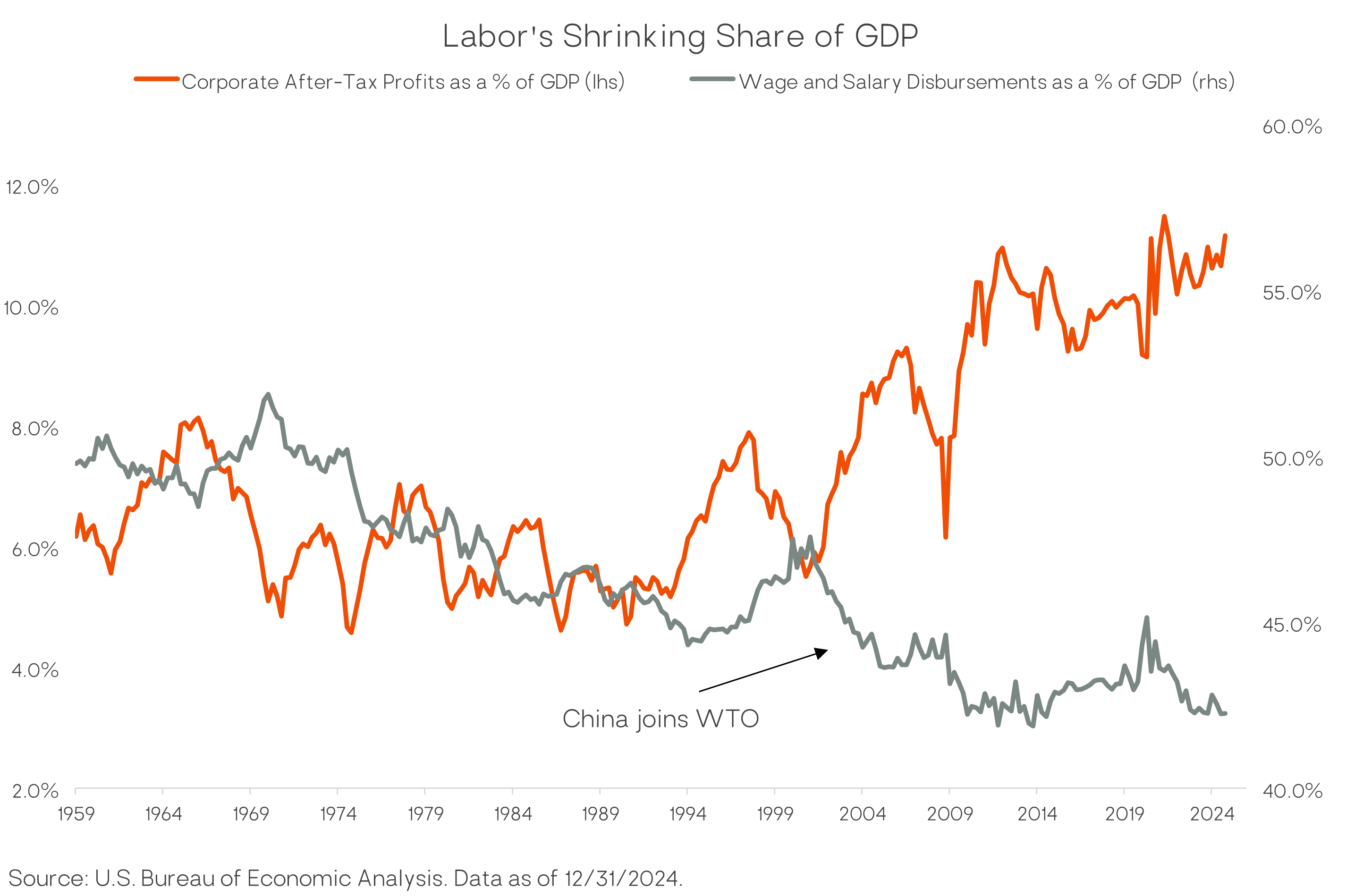
Perhaps the most surprising aspect of the tariff announcements was the methodology used to determine tariff levels. “Reciprocal tariff” is a misnomer because tariff levels are not based on matching the tariff levels imposed on the U.S. by other countries. Instead, the announced tariffs were primarily based on trade deficits, meaning that countries with a larger trade surplus with the U.S. are subjected to higher tariffs, whether or not they impose high tariffs on U.S. goods. In this form the tariffs are more of a blunt tool aimed at reducing trade deficits.
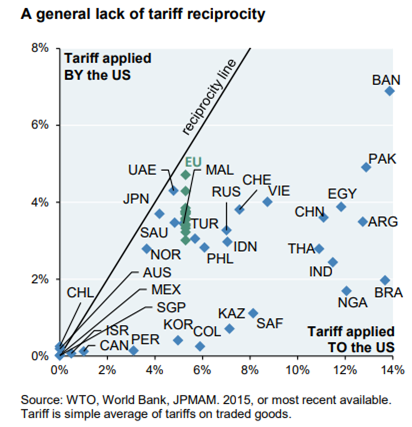
Because some of the tariff goals seem mathematically unworkable in certain countries due to the structure and scale of their trade with the U.S., it leads many to believe that the tariffs may serve a broader strategic purpose, potentially as a negotiating tool rather than a permanent fixture. Reportedly, numerous countries are seeking to address and potentially resolve trade tensions arising from the U.S. tariff policies. This includes the European Union, Japan, Vietnam, and Israel. Although we can’t know for sure, there appears to be a reasonable possibility that in some countries, these tariffs could be softened or rolled back over time as policy objectives are met or adjusted.
Meanwhile, the Federal Reserve finds itself in a challenging position amid the current tariff policy. While the “reciprocal” tariffs are a threat to growth, the likelihood of tariff-induced inflation complicates the Fed’s ability to respond aggressively with rate cuts. (Rate cuts would further fuel inflation.) Fed Chair Powell has been vocal that the current economic data does not warrant rate cuts, and the Fed remains hesitant to ease too quickly. Powell’s recent remarks suggest a commitment to data dependency, but the central bank is certainly coming under increasing pressure to support the economy as recession risks build. Should the labor market show further signs of deterioration, the Fed may be forced to act.
Global Stocks
Market participants were optimistic about U.S. stocks coming into 2025. The U.S “exceptionalism” trade, or the justification for higher price to earnings ratios for U.S. stocks, was alive and well and an incoming administration was expected to be more business friendly with deregulation and corporate tax cuts on the agenda. But the narrative around U.S. stocks started to shift in late-January beginning with the release of DeepSeek, a large language model out of China. DeepSeek had similar results as many current AI models but was reportedly trained at a fraction of the cost. Given the large sums of money U.S. technology companies have been spending to develop their own AI models, it sent shares lower for many AI-related stocks and raised questions about the capital spend needed. Because these tech companies were highly valued and priced for a bright future, any threat to their supremacy would hit their valuation multiples. This was one catalyst for the rotation out of U.S. large-cap growth stocks (Russell 1000 Growth), which lagged U.S. large cap value stocks (Russell 1000 Value) by a wide margin in the first quarter (negative 10% vs. positive 2.1%, respectively).
In early February, the trade war with Canada and Mexico commenced, serving as a trigger for some investors to pull back from U.S. stocks. For years, foreign investors have been heavily allocated to U.S. stocks, but increasing uncertainty around tariffs, as well as fiscal stimulus in Europe following the German elections, produced positive sentiment around European equities for the first time in years. European equities gained 10.5% during the first quarter, their widest quarterly outperformance gap versus U.S. equities in four decades. (See chart below.) A weaker U.S. dollar—down nearly 4%—during the quarter was meaningful tailwind for unhedged foreign assets.
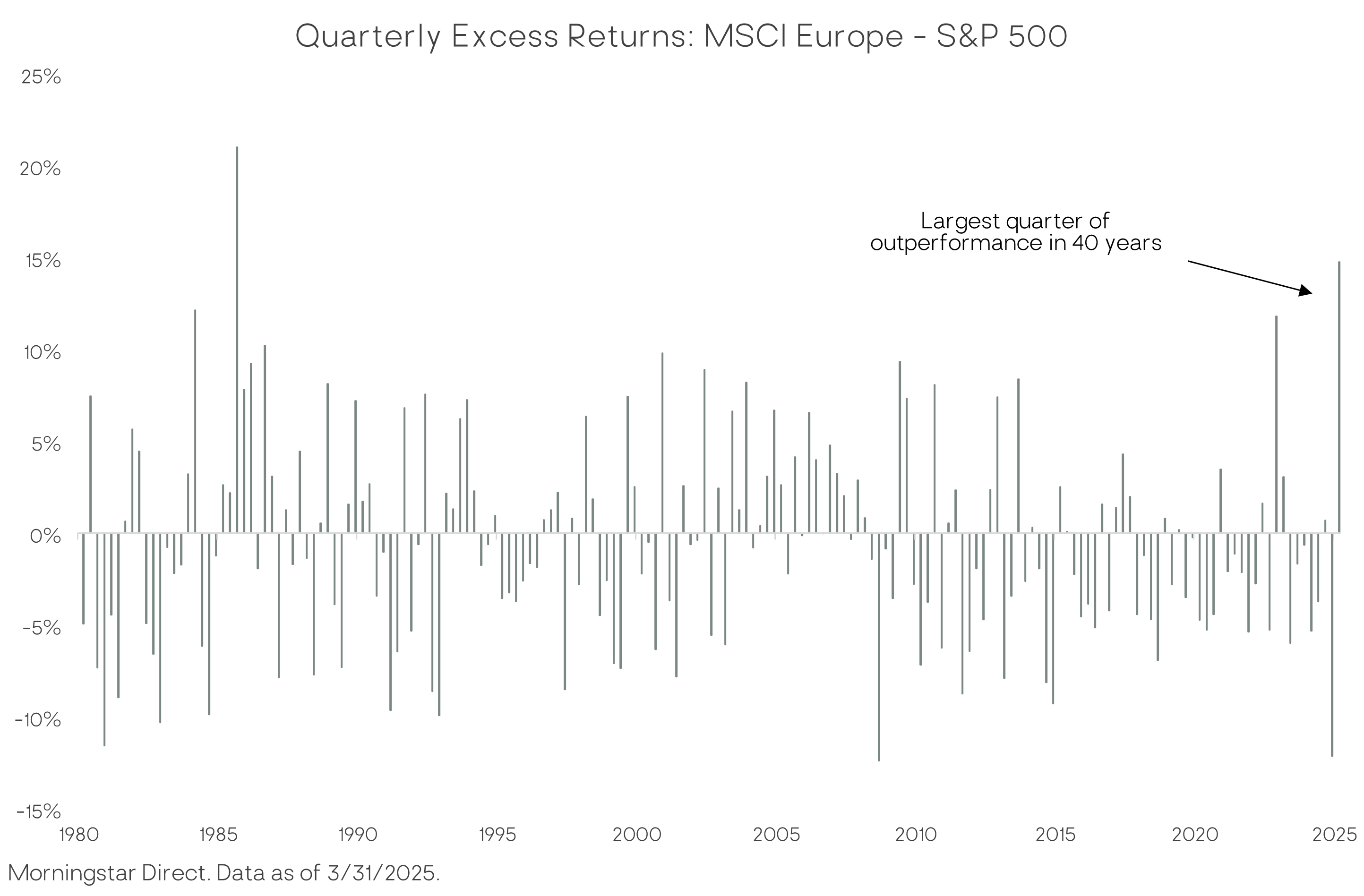
Fiscal stimulus, particularly from Europe’s largest economy in Germany, is emerging as a key catalyst for European equities. After decades of adhering to strict fiscal discipline, Germany’s new government has signaled a shift toward expansionary policies this year to boost the stagnant economy and increase national security. A proposed €500 billion infrastructure investment fund, alongside increased defense spending of similar size, marks the country’s largest fiscal package in decades, outstripping both the spend on Reunification and the World War II Marshall Plan in relative percentage of GDP. The stimulus is expected to boost euro-area GDP growth by an estimated 0.5% to 1% in 2025, with ripple effects across the region.
Beyond Germany, broader European fiscal dynamics are also supportive. The prospect of a ceasefire in Ukraine could unlock reconstruction spending potentially worth hundreds of billions of euros, benefiting construction, industrial, and energy sectors. Additionally, the European Central Bank has adopted a more accommodative stance, cutting interest rates multiple times since mid-2024, with further reductions anticipated through mid-2025. Lower borrowing costs, combined with fiscal loosening, could stimulate economic activity and bolster equity markets.
Undoubtedly the biggest risk to a continued resurgence in Europe does not come from inside the Eurozone, but from the United States. The imposition of wide-ranging tariffs from the Trump administration is anticipated to negatively affect economic activity globally. Europe is particularly sensitive to planned tariffs targeting the automobile sector, which comprises a full 7% of the bloc’s GDP. While the potential for any negotiated exemptions could provide a positive catalyst, there is a high degree of uncertainty surrounding the final scope and impact of any tariff measures.
Equity Volatility
The 10% decline in the S&P 500 during the first quarter led to heightened market anxiety, but history suggests that corrections are a normal part of long-term investing and do not always signal a crisis. Since 1950, the market has experienced 34 corrections of this magnitude, yet only about a third have escalated into bear markets with losses exceeding 20%.
While today’s concerns around higher interest rates, government layoffs, and shifting trade policies add to uncertainty, we still believe the broader economic backdrop (for now at least) remains relatively stable. Employment data and consumer spending trends, while under pressure, have not yet deteriorated to levels that historically coincide with recessions. Additionally, as mentioned above, corporate earnings estimates have been holding up although forward estimates have declined a bit. Historically, stock market corrections recover within a few months, and investors who stay the course often benefit as markets rebound. While it is prudent to monitor risks, particularly if economic conditions worsen, it is too early to classify this market downturn as a crisis. Long-term investors should maintain perspective, recognizing that market cycles of fear and relief are natural, and history has consistently rewarded patience and disciplined investing.
During periods of heightened volatility, we find it valuable not to overreact to the latest headline that could tempt investors to sell their equity exposure. In periods of market stress, we believe the two-part decision (when to sell and when to jump back in) of market timing is a long-term losing proposition. Markets are not in full meltdown at this point, but at the 10% correction level we often field more questions about selling to side-step further losses.
Ultimately, in periods of equity declines, we are biased to be buyers instead of sellers. In the past we’ve highlighted how detrimental missing the best days in the stock market can be on long-term returns. Perhaps surprisingly, the stock market’s largest daily gains don’t occur during prolonged bull markets, they happen during bear markets. The table below shows that all 10 of the largest daily gains over the last 75 years have happened inside of a recession.
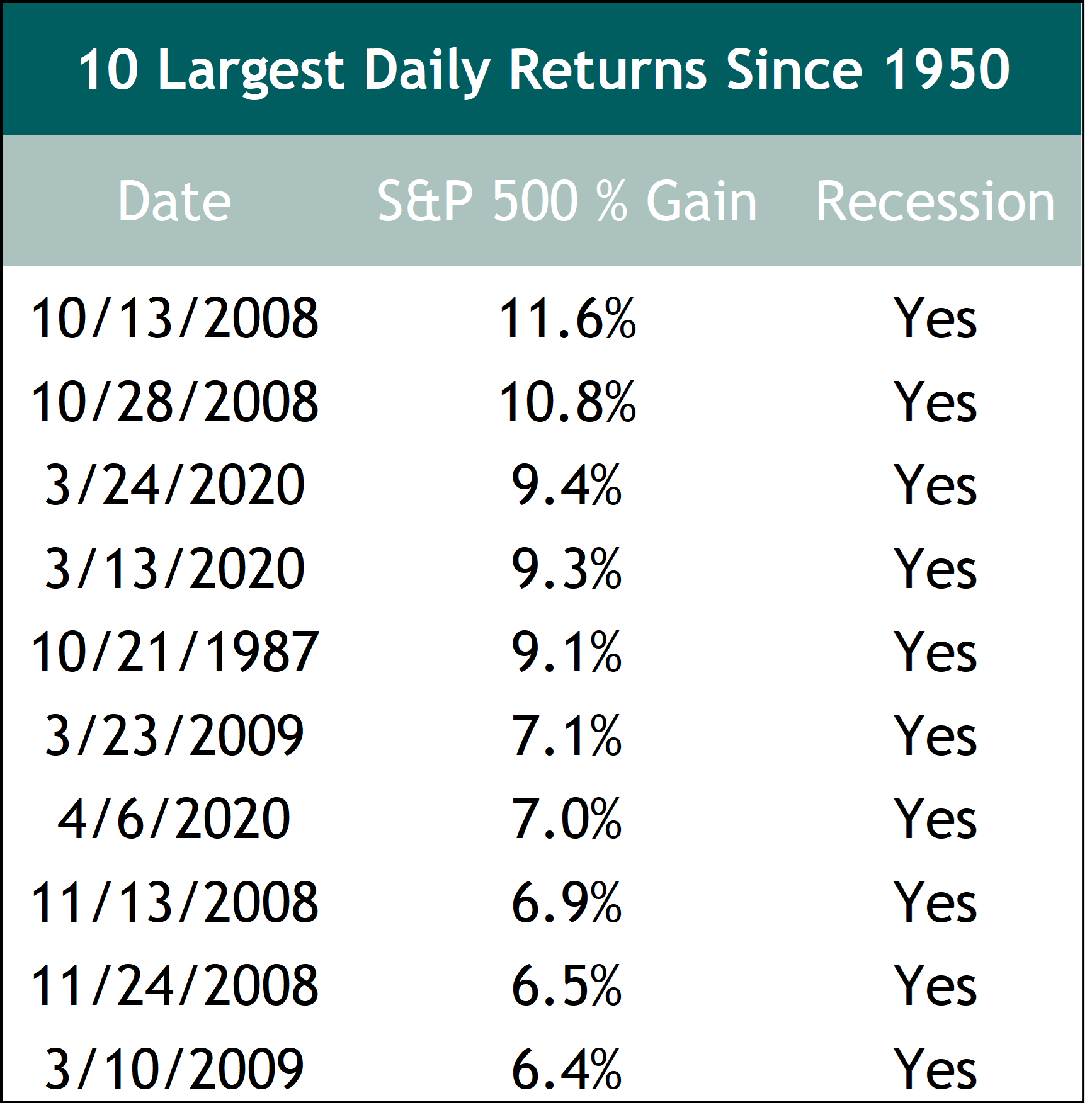
Source: Morningstar Direct. Data shown 1/1/1950 – 3/31/25
Fixed-Income
The first quarter was marked by volatility in U.S. fixed-income markets as investors reacted to shifting Federal Reserve expectations, persistent inflationary pressures, resilient economic data, and constantly changing tariff policies. Treasury yields remained elevated, with the 10-year yield holding above 4.2%, as markets reassessed the timing and magnitude of potential Fed rate cuts. Credit markets performed well, supported by strong corporate earnings and stable fundamentals, while high-yield spreads remained relatively tight despite broader macro uncertainty.
Meanwhile, the Fed continues to balance inflation risks with signs of slowing growth. While early-year expectations pointed to multiple rate cuts in 2025, persistent inflation in the services sector and wages led the market to scale back its rate-cut projections. As of March, the Fed is expected to hold rates steady through mid-year, with the potential for two to three cuts in the second half of the year, assuming inflation continues to moderate.
During the quarter, long-term rates have remained sticky, with the 10-year Treasury yield trading in a range between 4.2% and 4.5%. The yield curve remains inverted (using the 3-month and 10-year Treasury yields), signaling cautious economic sentiment, but recent steepening suggests a shift in market expectations toward more normal rate conditions over time. The direction of long-term yields will depend on how quickly inflation subsides and whether growth remains resilient enough to prevent an aggressive Fed easing cycle.
Corporate bond markets also remained well-supported by solid earnings growth, strong balance sheets, and manageable refinancing needs. Investment-grade credit spreads have stayed tight, reflecting confidence in corporate fundamentals, while high-yield bonds continue to benefit from a lack of imminent default risks. The trailing 12-month default rate was a healthy .25% at the end of February. However, as financial conditions tighten and economic growth slows, credit differentiation will become more important, favoring companies with strong cash flows and lower leverage.
Alternatives
Alternative investments have faced a choppy and unpredictable start to 2025, following mixed performance in 2024. “Trend following” managed futures, in particular, had a roller coaster year—strong early gains faded through much of 2024 before a late-year rebound helped the SG CTA Index finish the year up 2.4%. That positive momentum initially carried into 2025, but the rapid unwinding of so-called “Trump trades”—ironically after policy implementation—has made for a tough environment. These strategies tend to thrive on clear, sustained market trends but have struggled amid sharp reversals. The SG CTA Index was down 2.5% through the end of March (and the SG Trend Index was down 4.7%), with losses particularly concentrated in currency trades.
So far, 2025 has proven to be an unpredictable and fast-moving market, shaped by major shifts in economic policy, trade, and foreign relations. In such an environment, traditional investment strategies that have dominated for the past 15 years may not be as reliable, reinforcing the case for alternatives as valuable diversifiers in a well-balanced portfolio.
Portfolio Positioning
Ongoing market volatility is being driven by uncertainty around the administration’s tariff policy, which will likely dictate the economic and investment outlooks. The duration and severity of the tariffs will play a pivotal role in U.S. and global growth in the months ahead. If tariffs remain in place or are even escalated, it will negatively impact the consumer and business investment, and push the economy closer to recession, if not into a recession. Conversely, any signs of a de-escalation or exemptions could quickly stabilize the markets and restore confidence. We saw a glimpse of what could happen on April 7, when an intra-day rumor of a 90-day pause on tariffs temporarily pushed the U.S. market higher by about seven percentage points off its low before the rumors were squashed and the market settled lower. We remain cautious, maintaining diversification, closely monitoring events as the tariff policy path from here will have an outsized influence on the market.
At the portfolio level, our fixed-income exposure continues to favor our positions in shorter-dated bonds, most of which is high-quality and earning yields above the benchmark. Uncertainty surrounding inflation, interest rates, and global economic conditions has led to a heightened sense of unpredictability in the bond market. We have seldom seen long-term bond yields this volatile and it remains anyone’s guess where Treasury yields are headed next with market participants closely watching for any signs of policy shifts or further economic developments that could steer the direction of yields. In this uncertain environment, we are maintaining our bird-in-hand approach, prioritizing attractive absolute returns over trying to predict the timing and magnitude of interest-rate moves. Our focus is on generating reliable, steady returns that align with our broader investment goals, ensuring we are well-positioned regardless of where market rates head next. If yields move too far lower or higher, it could trigger a change in our fixed-income exposure.
Within the equity markets, we acknowledge that U.S. equity valuations remain elevated versus their global peers. The current selloff has resulted in meaningful valuation compression as forward earnings estimates remain largely unchanged. U.S. stocks have gone from historically expensive to a more reasonable range in a matter of weeks. But whether cheap or expensive, valuations are terrible timing tools, and that from current levels we do think it’s reasonable to think today’s U.S. equity valuations will dampen the level of future returns. While investors happily paid a premium multiple for U.S. earnings, actions around trade policy could narrow that premium as foreign investors look to repatriate money, and reconsider investing the marginal dollar into U.S. assets. This brings us back to the benefits of diversification—which we use as a tool to augment returns and reduce volatility, where we maintain exposure to international equities. Case in point is the year-to-date period through March, where developed international stocks are widely outperforming the U.S.
Closing Thoughts
It goes without saying that tariffs and trade policy have injected a big dose of uncertainty into the financial markets, and we understand that such developments can be worrying. There are still many lingering questions, including what potential retaliatory measures will come from countries hit with tariffs, whether the announced tariff levels will remain in place or possibly be lowered, and what their ultimate impact will be on the financial markets. Until there is more clarity, the volatile environment will likely continue.
Stock prices do at least appear to reflect some of the current negative and unexpected news related to the impact of announced tariffs. While many foreign and U.S. economies were in relatively good shape prior to “Liberation Day,” the potential impact on the economy from these tariffs has led to an increased possibility of a recession in the near-term. Therefore, in our scenario analysis we are actively assessing a range of potential economic outcomes and their impact on the markets before we consider a potential shift in portfolio allocations.
The current market environment is volatile and tough to predict with any confidence. More than ever, we believe it’s important to stay disciplined and avoid making reactive portfolio shifts. This is a challenging environment, but one that reinforces the importance of diversification, patience, and a clear investment process.
General Disclosures
This investment commentary is provided by Litman Gregory Wealth Management, LLC (“LGWM”) for informational purposes only. It is not intended as investment advice or a recommendation to buy or sell any security, nor should it be construed as legal or tax advice. The information may not be suitable for all investors and does not constitute a solicitation or offer to transact in any investment product or strategy.
The views expressed are those of the investment team as of the date of publication and are subject to change without notice due to evolving market or economic conditions. There is no guarantee that any forecasts or projections will be realized. All forward-looking statements are based on current expectations and assumptions and involve known and unknown risks and uncertainties that may cause actual results to differ materially.
Past performance is not indicative of future results. All investing involves risk, including the potential loss of principal. No investment strategy can guarantee a profit or protect against loss in periods of declining values.
Indices referenced are for illustrative purposes only as benchmarks to help gauge general market or sector performance. They are not directly investable, do not reflect the deduction of management fees or transaction costs, and do not represent actual or expected portfolio returns. Index data is sourced from unaffiliated third parties, and while believed to be reliable, LGWM does not guarantee its accuracy, completeness, or timeliness.
Any hypothetical, target, or projected returns presented are provided for illustrative purposes only, do not represent actual performance, and are not guarantees of future results. These figures are based on assumptions that may not be realized and are subject to change. Modeling inputs include historical market data, anticipated cash flows, market dynamics, valuation estimates, and other factors, and actual outcomes may vary materially, especially under extreme market conditions.
This material is not intended to predict future events, and nothing herein should be interpreted to reflect the performance of any specific investment strategy or account.
A complete list of portfolio holdings and specific securities transactions for the preceding 12 months is available upon request by contacting: [email protected].
LGWM is an SEC-registered investment adviser with its principal place of business in the state of California. Registration does not imply a certain level of skill or training. LGWM may only transact business in states in which it is registered or qualifies for an exemption or exclusion from registration requirements. Any direct communication with prospective clients will be conducted by an appropriately registered representative.
Index Disclosure
-
S&P 500 Index:
The Standard & Poor’s 500 Index (S&P 500) is a market capitalization-weighted index of 500 of the largest publicly traded U.S. companies. The index is designed to be a leading indicator of U.S. equities and reflects the risk/return characteristics of the large-cap universe.
-
Russell 1000 Growth Index / Russell 1000 Value Index:
The Russell 1000 Growth Index measures the performance of the large-cap growth segment of the U.S. equity universe, while the Russell 1000 Value Index measures the performance of the large-cap value segment. Both indices are subsets of the Russell 1000 Index and represent companies with higher or lower price-to-book ratios, respectively.
-
MSCI EAFE Index:
The MSCI EAFE Index is a free float-adjusted market capitalization index designed to measure the equity market performance of developed markets outside of the U.S. and Canada, including Europe, Australasia, and the Far East.
-
MSCI Emerging Markets (EM) Index:
The MSCI EM Index captures large- and mid-cap representation across 24 emerging market countries, covering approximately 85% of the free float-adjusted market capitalization in each.
-
MSCI China Index:
The MSCI China Index captures large- and mid-cap representation of Chinese equities listed in China and offshore, including H shares, B shares, Red chips, P chips, and foreign listings.
-
Bloomberg U.S. Aggregate Bond Index:
The Bloomberg U.S. Aggregate Bond Index is a broad-based, market value-weighted benchmark that measures the investment-grade, U.S. dollar-denominated, fixed-rate taxable bond market, including Treasuries, government-related and corporate securities, mortgage-backed securities, and asset-backed securities.
-
SG CTA Index / SG Trend Index:
The SG CTA Index is a performance benchmark of leading managed futures strategies compiled by Société Générale, representing the largest Commodity Trading Advisors (CTAs) by assets under management that are open to new investment. The SG Trend Index is a subset that measures the performance of trend-following CTAs specifically.
